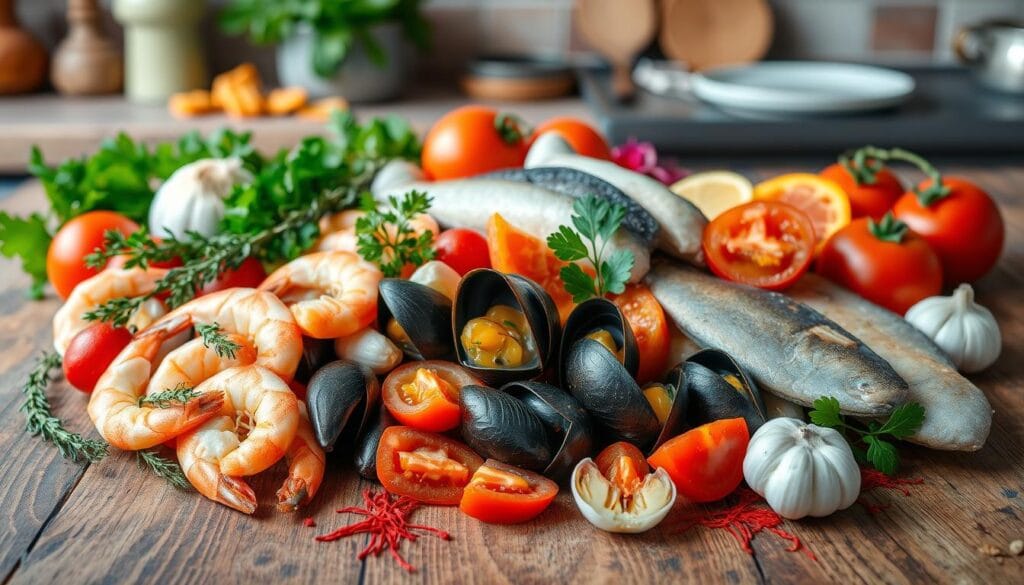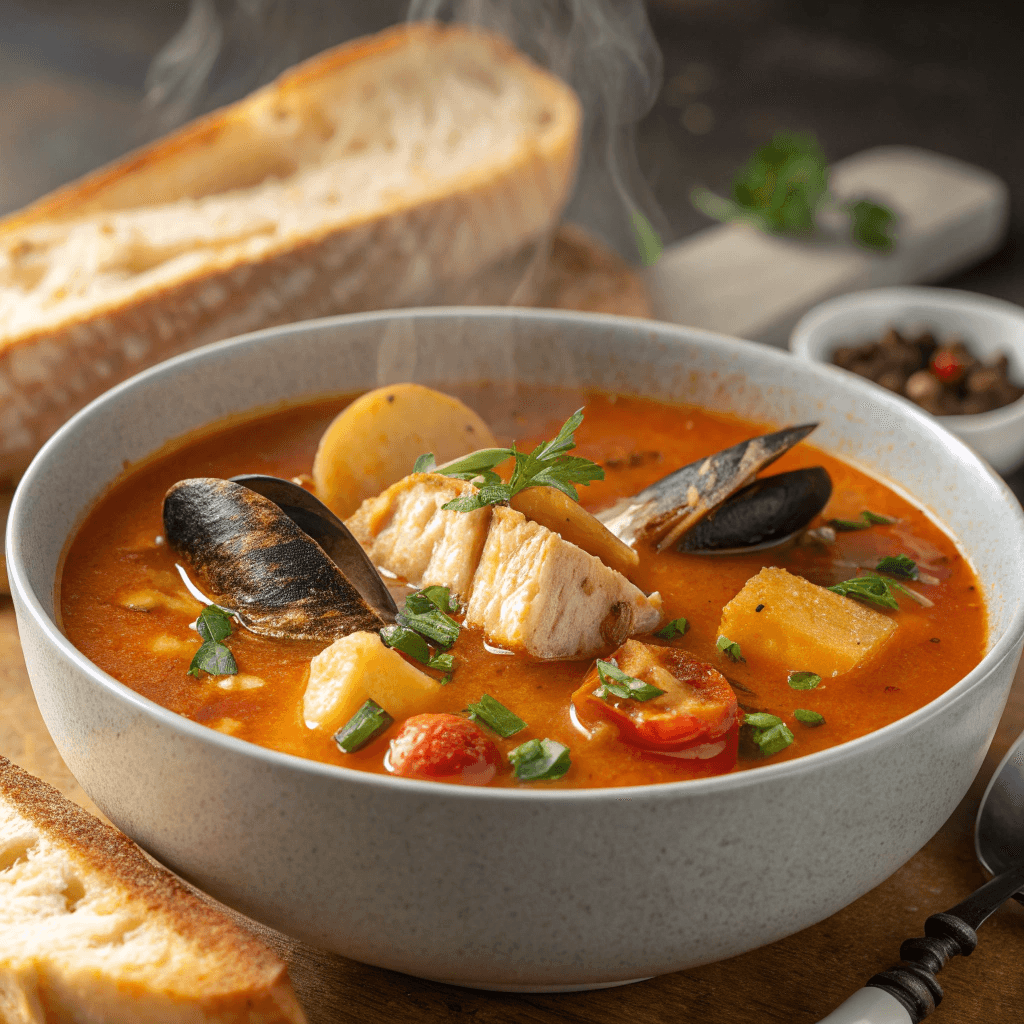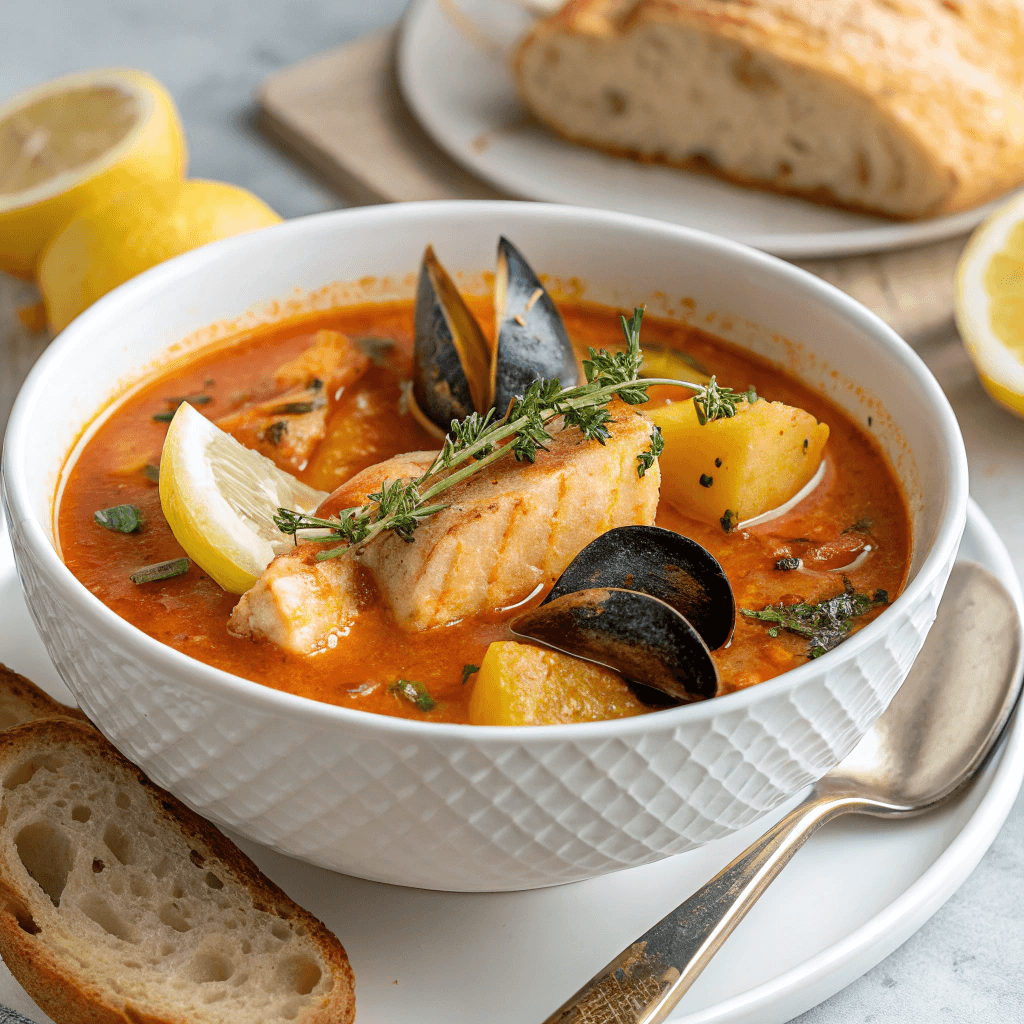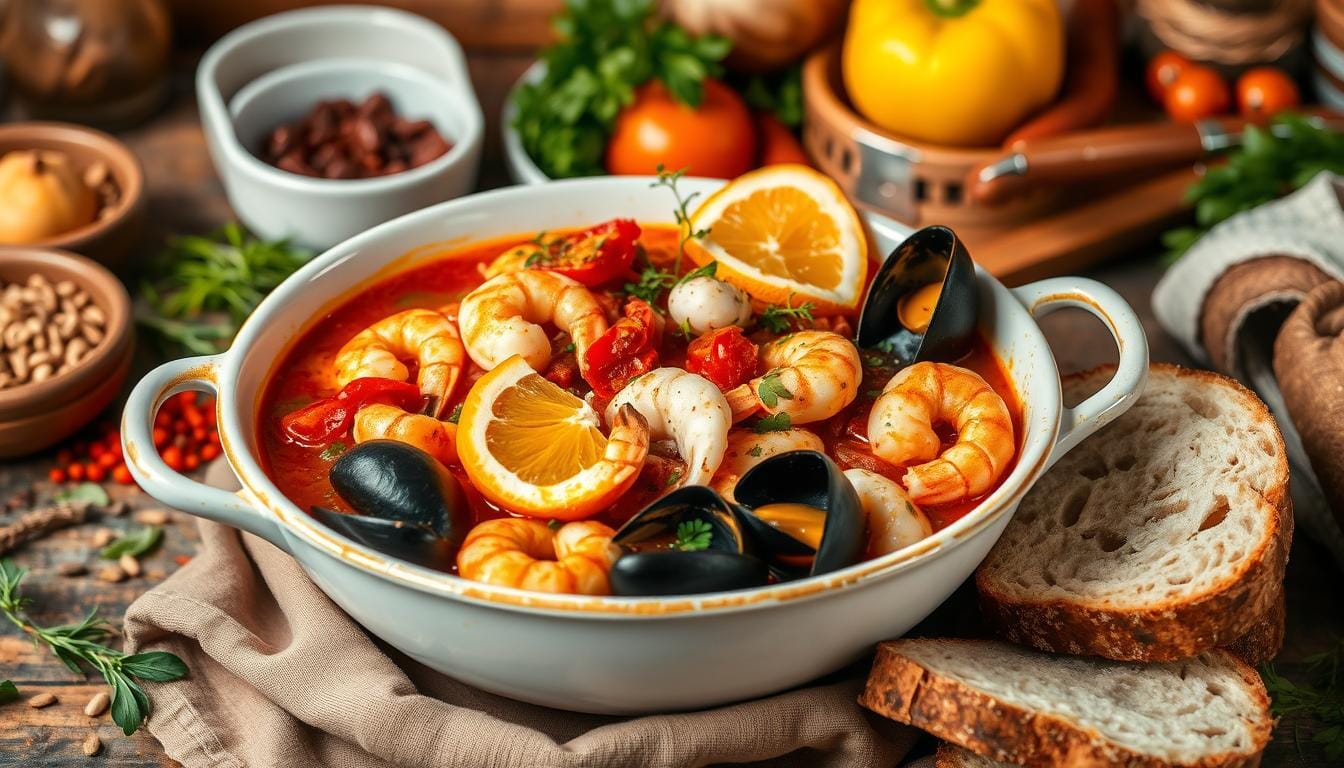Mastering the Art of Bouillabaisse: A Flavorful Feast
The first time I tasted bouillabaisse; it was like capturing the entire Mediterranean Sea on a single spoon. This legendary Provençal seafood stew isn’t just a dish—it’s a culinary journey. It transforms simple ingredients into an extraordinary gastronomic experience.
Originating from the sun-drenched port of Marseille, bouillabaisse represents more than a traditional seafood stew. It embodies the rich maritime heritage of southern France. Here, fishermen crafted incredible meals from their daily catch. Each spoonful tells a story of coastal resilience, passion, and incredible flavor.
Imagine a dish that combines multiple types of fresh fish, aromatic herbs, and a broth so complex it could rival the most sophisticated culinary creations. That’s fish stew—a testament to Provençal cuisine’s remarkable ability. It elevates humble ingredients into something truly spectacular.
Table of Contents
Key Takeaways
- Bouillabaisse is a traditional Provençal seafood stew from Marseille
- The dish reflects the maritime culinary heritage of southern France
- Authentic fish stew uses multiple types of fresh fish
- Preparation requires careful selection of ingredients and techniques
- The stew represents more than a meal—it’s a cultural experience
Understanding the Origins of Provençal Fish Stew
The story of this recipe starts in Marseille, a lively port city. Here, Mediterranean tastes blend with long-standing cooking traditions. It began in fishermen’s kitchens, turning leftover catch into a culinary gem.

The Roots of Mediterranean Coastal Cuisine
In Marseille, fishermen created fish stew to use up their catch. They mixed rockfish and other seafood into a hearty stew. This showed their clever use of resources.
- Originally made with 3-5 different seafood types
- Utilized fish that could not be sold in markets
- Developed as a practical meal for working fishermen
From Fishermen’s Meal to Culinary Icon
What started as a simple meal became a famous dish. Its growth shows how Provence’s sea culture led to new cooking ideas.
“Bouillabaisse is more than a meal; it’s a story of Marseille’s maritime heritage told through flavor.” – Provençal Culinary Historian
Traditional Marseille Preparation Methods
Making fish stew is a detailed process. It starts with a flavorful broth and then poaching fresh fish. The whole thing takes about 2 hours and 30 minutes, with methods passed down through generations.
| Preparation Element | Details |
|---|---|
| Total Preparation Time | 2 hours 30 minutes |
| Fish Varieties | Scorpionfish, Red Mullet, Skate, Conger Eel |
| Typical Fish Weight | 300-400 grams per piece |
| Serving Size | Approximately 6 people |
Learning about bouillabaisse is like seeing its journey. It went from a simple fisherman’s meal to a beloved dish around the world.
Essential Ingredients for Authentic Bouilla-baisse

Making a real fish soup needs the right Mediterranean ingredients. These ingredients turn a simple dish into a masterpiece. Your Soup journey starts with knowing the key parts that make this saffron broth special.
Fish Selection
The heart of a great bouillabaisse is its fish mix. Chefs say using different fish textures adds depth and complexity. Your fish mix might include:
- Black sea bass
- Halibut
- Monkfish
- Cod
- John Dory
Essential Seafood Components
To make your tomato-based broth better, add these seafood treats:
- 12 large prawns
- 3 lbs mussels
- 2 lb lobster
Aromatic Foundations
The secret to a real fish stew is its aromatics. Your flavor base should have:
- 8 crushed garlic cloves
- 2 Spanish onions
- ½ bulb fennel
- 4 celery stalks
- 2 large carrots
“The magic of bouillabaisse is in its ingredients, carefully selected and lovingly prepared.” – Marseille Culinary Tradition
Every ingredient is key to the rich, complex flavor of this Mediterranean dish. Paying attention to ingredient quality turns a simple fish soup into a memorable culinary experience.
The Art of Creating the Perfect Fish Stock Base
Making a great fish soup begins with a perfect fish stock base. The success of your fish stew depends on the right fish mix and the balance of flavors. These elements turn a simple saffron broth into a culinary masterpiece.
Selecting the Right Fish Combinations
For your fish soup, pick a mix of white fish for depth and complexity. Good combinations include:
- Red mullet
- Sea bass
- Monkfish
- Scorpion fish
“The secret to a remarkable bowl of fish stew lies in the quality and diversity of your fish selection.”
Aromatics and Seasonings
Your saffron broth needs a mix of aromatics for rich flavors. Key ingredients are:
- Fresh fennel
- Garlic
- Leeks
- Bay leaves
Saffron: The Golden Secret
Saffron makes your fish soup special. This golden spice adds a unique flavor and color, making your fish stew authentic.
| Ingredient | Quantity | Purpose |
|---|---|---|
| Saffron | ¼ teaspoon | Adds color and distinctive flavor |
| White Wine | 2 cups | Enhances stock depth |
| White Fish | 3 pounds | Primary protein base |
Remember, patience and precision are key when making your fish stock. Simmer it for about 30 minutes to get the best flavor. This will make your saffron broth unforgettable, taking your bouillabaisse to the next level.
Mastering the Seafood Selection Process
Making a great seafood stew starts with picking the right seafood. In Marseille, where fish stew was born, chefs follow strict rules for fish. Knowing which seafood to use is key to a delicious coastal French dish.
This Recipe needs a special mix of Mediterranean fish. The 1980 Marseille Bouillabaisse Charter lists the must-haves:
- Sea bass
- Red mullet
- Rascasse (a local rockfish)
- Haddock
- Halibut
Pro tip: Stay away from oily fish like salmon and mackerel. They can overpower your stew’s flavors.
“The soul of bouillabaisse lies in its fish selection” – Marseille Culinary Tradition
Choose fresh and varied seafood. The Michelin Guide says use at least three fish types. Pick firm-textured fish that holds up well to cooking.
Shellfish add richness to your dish. Consider adding:
- Mussels
- Squid
- Crab
A true fish stew is all about balance. Each fish should add its own flavor. This way, your stew will be a true taste of Provençal cuisine.
The Role of Fresh Mediterranean Herbs and Spices
Provençal cuisine is all about the vibrant Mediterranean flavors. These flavors turn simple ingredients into amazing dishes. In fish stew, herbs and spices are not just for taste. They are the heart of the recipe, offering a taste of Southern France’s coast.
Knowing how to mix herbs is key to making this seafood stew great. The Mediterranean has many aromatic ingredients. They make the dish more complex and interesting.
Essential Herb Combinations
These classic herb pairings will bring your fish stew to life:
- Fresh parsley for bright, green notes
- Thyme to add earthy undertones
- Bay leaf for subtle depth
- Marjoram for delicate sweetness
Balancing Flavors with Fennel and Garlic
Fennel and garlic are key to Mediterranean flavors. Together, they create a strong taste that’s true to Provençal cuisine.
“Herbs are the magic wands that transform a simple fish stew into a culinary masterpiece.” – Provençal Cooking Wisdom
Garlic gives a strong taste, while fennel adds a sweet anise flavor. Together, they make a perfect mix. This mix makes sure every spoonful is full of flavor and character.
By picking and mixing these herbs well, you’ll get the true taste of traditional fish stew. It will take you to the sunny shores of Marseille.


Traditional Cooking Techniques and Timing
Learning to make fish stew is all about precision. The Mediterranean flavors need a careful cooking process. This turns simple ingredients into a remarkable seafood stew.
Start by making a strong fish stock. Choose your ingredients wisely to create deep flavors:
- Sauté aromatics (onions, leeks, fennel) for 5-7 minutes
- Add organic tomatoes and simmer for 3-4 minutes
- Introduce warm water (1-1.5L) to develop the base
Choosing the right seafood is key in making traditional fish stew. Timing is everything when adding different fish types:
| Seafood Type | Cooking Time | Preparation Notes |
|---|---|---|
| Monkfish | 12-15 minutes | Cook until opaque and firm |
| Prawns | 5-10 minutes | Add near end of cooking |
| Scallops | 3-5 minutes | Quick cooking to maintain tenderness |
“In Provençal cuisine, patience transforms simple seafood into a culinary masterpiece.” – Marseille Chef Tradition
Finish by adding a pinch of saffron just before serving. This boosts the Mediterranean flavors and gives your bouillabaisse a golden, aromatic finish.
Preparing the Classic Rouille Sauce
Rouille sauce is a key part of Marseille’s culinary scene. It turns fish stew into a true masterpiece. This sauce adds depth and spice, making your seafood dish a true Mediterranean feast.
Making rouille sauce is all about the right ingredients and how you mix them. First, you need to know what goes into this Provençal sauce.
Key Ingredients for Authentic Rouille
- Roasted red peppers (25 oz)
- Fresh garlic (3 cloves)
- High-quality olive oil (1/4 cup)
- Egg yolk (1)
- Lemon juice (1 Tbsp)
- Breadcrumbs (1/4 cup)
- Cayenne pepper (1/4 tsp)
Step-by-Step Preparation Guide
- Roast red peppers until skin is charred and blistered
- Peel and seed the roasted peppers
- Mince garlic finely
- Blend roasted peppers with garlic
- Gradually whisk in olive oil
- Add egg yolk and lemon juice
- Incorporate breadcrumbs for thickness
- Season with cayenne pepper
“The perfect rouille sauce is a delicate balance of heat, richness, and Mediterranean flavors.” – Provençal Cooking Tradition
When making rouille sauce, be patient and precise. It should be smooth, like aioli, to match bouillabaisse’s rich taste.
| Ingredient | Quantity | Purpose |
|---|---|---|
| Roasted Red Peppers | 25 oz | Base flavor and color |
| Olive Oil | 1/4 cup | Smooth texture and richness |
| Cayenne Pepper | 1/4 tsp | Spicy kick |
Offer your rouille sauce with toasted sourdough bread. This lets guests add it to their fish stew.
Serving and Presentation Guidelines
Serving bouillabaisse is special. It’s a seafood stew from Provençal cuisine. It’s served in a way that makes eating a fun experience.
- Separate serving of broth and seafood
- Accompaniment of crusty bread and rouille
Presenting fish stew is like art. Start by pouring the broth into wide bowls. The broth should be golden, full of saffron and herbs.
“A true bouillabaisse is not just a meal, but a celebration of the sea’s bounty.”
Seafood is placed on a platter. This lets diners pick their favorites. Here’s what you should have:
| Seafood Type | Quantity (for 6 servings) |
|---|---|
| Monkfish | 1 pound |
| Hake | 1 pound |
| Shrimp or Prawns | 1 pound |
| Mussels | 1 pound |
Add fresh herbs to make it look good. A Provençal rosé is perfect to drink with it. It makes the meal feel like a true Mediterranean feast.
Wine Pairing Suggestions for Bouillabaisse
Finding the perfect wine for fish stew is key. It’s all about the Mediterranean tastes in this French dish. The right wine can make your meal even better, matching the seafood stew perfectly.
Here are some top picks for wine pairings:
- Dry Sparkling Wines: Champagne or Prosecco offer crisp accompaniment
- Light Red Wines: Beaujolais or Gamay provide delightful contrast
- Bone Dry Whites: Chablis brings out the subtle seafood nuances
Experts say to choose wines with high acidity. This matches the bold flavors of fish stew. Unoaked white wines are best, as they don’t hide the seafood’s delicate taste.
“The right wine transforms a good meal into an extraordinary culinary journey” – Wine Pairing Expert
Looking for specific wine suggestions? Here are some great choices:
- Albariño: Complements the rich seafood base
- Provence Rosé: Mirrors the coastal origins of fish stew
- Grüner Veltliner: Offers bright, crisp undertones
Remember, your wine choice should boost the dish’s flavors, not hide them. This way, you’ll enjoy the full taste of this classic French dish.
Common Mistakes to Avoid When Making Bouillabaisse
Making a true seafood stew needs precision and care. When you make fish stew, a classic dish from Provence, you must avoid common mistakes. These mistakes can ruin your dish.
“Perfection in cooking is about understanding ingredients and respecting traditional techniques”
Here are the main mistakes home cooks often make when making this seafood stew:
- Overcooking seafood, which destroys delicate textures and flavors
- Using low-quality or frozen fish instead of fresh Mediterranean catch
- Neglecting proper fish stock preparation
- Rushing the cooking process
- Ignoring traditional Provençal seasoning techniques
Your seafood choice is very important. Fresh, high-quality fish makes all the difference. About 58% of home cooks feel more satisfied with fresh ingredients than prepackaged ones.
Here are some tips to avoid common mistakes:
- Select a variety of fresh fish with different textures
- Cook fish briefly to maintain tenderness
- Use saffron and traditional herbs generously
- Allow adequate time for flavor development
Understanding these tips will make your bouillabaisse amazing. It will honor the rich culinary heritage of Provence.
Conclusion
Your journey into fish stew shows a true culinary gem from Provençal cuisine. It’s more than a recipe; it’s a story of coastal cooking passed down through generations. This dish connects us through its detailed preparation and rich traditions.
Bouillabaisse is a symbol of culinary creativity, from Marseille’s ports to kitchens worldwide. It lets home cooks try different seafood, like red scorpionfish and langoustines. Yet, it keeps its essence of making simple ingredients into something amazing.
Exploring fish stew means more than following a recipe. It’s about a cooking way that values fresh ingredients, precise methods, and the lively spirit of Mediterranean coastal areas. Every time you make it; you join a long tradition of French food heritage at your table.
Whether you’re an experienced chef or a curious home cook, fish stew invites you to explore, create, and enjoy a remarkable culinary journey. It continues to enchant food lovers everywhere.
FAQ
What exactly is fish stew?
What fish are typically used in an authentic fish stew?
How is fish stew different from other seafood stews?
What is rouille, and why is it important?
What wine pairs best with bouillabaisse?
Is fish stew difficult to prepare at home?
Can I substitute fish if I can’t find traditional Mediterranean varieties?
What are the essential herbs and spices in fish stew?
How Was It?
There are no reviews yet. Be the first one to write one.

